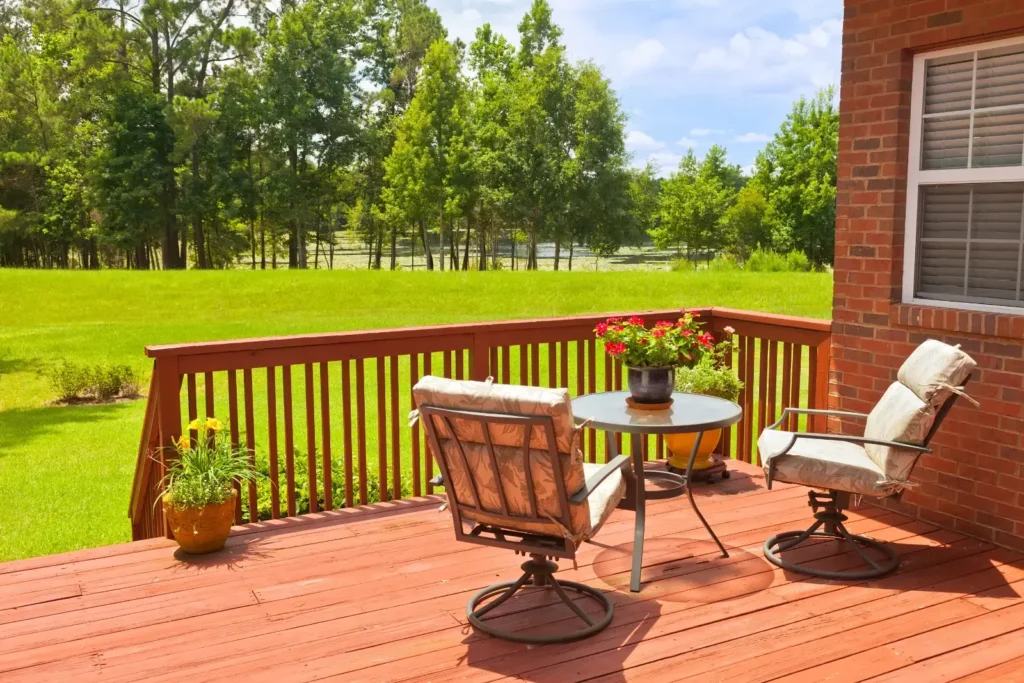A well-designed outdoor space can significantly enhance your home’s appeal and even increase its property value. According to recent trends, homes with thoughtfully designed outdoor living areas tend to have a higher market value.
When it comes to creating an outdoor living space, deck design plays a crucial role in complementing your home architecture. A seamlessly integrated deck not only elevates your home’s aesthetic but also provides a functional area for relaxation and entertainment.
By considering the style and structure of your home, you can build a deck that perfectly ties in with your home’s overall design, creating a harmonious transition between indoors and outdoors.
Understanding Your Home’s Architectural Style
To create a deck that complements your home, you need to understand its architectural style. Different styles have distinct characteristics that should be considered when choosing deck materials, colors, and design features.
Common Architectural Styles in American Homes
American homes feature a wide range of architectural styles, including modern, traditional, and rustic. Modern homes often have clean lines, minimal ornamentation, and an emphasis on functionality. Traditional homes typically feature classic elements, such as columns, arches, and ornate details.
| Architectural Style | Characteristics | Deck Features |
| Modern | Clean lines, minimal ornamentation | Sleek railings, minimalist decor |
| Traditional | Classic elements, ornate details | Ornate railings, classic wood finishes |
| Rustic | Natural materials, earthy tones | Reclaimed wood, natural stone features |
Identifying Key Design Elements
To match your deck to your home’s architectural style, you need to identify its key design elements. Look for features such as roof shape, window style, and exterior finishes.
Matching Deck Features to Your Home’s Character
Once you’ve identified your home’s architectural style and key design elements, you can choose deck features that complement its character. For example, a modern home might require a sleek, minimalist deck design, while a traditional home might benefit from a classic wood deck with ornate railings.
Essential Planning Steps for Building a Deck
The key to a successful deck construction lies in thorough planning and preparation. Before you begin building your deck, it’s essential to determine its purpose. Will it be used for entertaining guests, or as a quiet retreat?Understanding the deck’s purposewill help you decide on its size, shape, and features.
Assessing your site is another crucial step in deck planning. You need to consider factors such as sun exposure, wind direction, and the view from your deck. For instance, if your yard receives direct sunlight for most of the day, you may want to include shading elements like pergolas or umbrellas. As noted by one of the best deck builders Calgary, “A well-designed deck takes into account the surrounding environment to create a harmonious outdoor space.”
Creating a budget is also vital in the planning process. You need to decide how much you are willing to spend on your deck construction project. Consider the cost of materials, labor, and any additional features you want to include, such as lighting or built-in seating. A well-planned budget will help you avoid cost overruns and ensure that your project stays on track.
Other essential planning steps include deciding on the deck’s size and shape, choosing the right materials, and ensuring compliance with local building codes and regulations. By following these steps, you can create a deck that not only enhances your home’s architecture but also provides a functional and enjoyable outdoor living space.
- Determine the deck’s purpose and functionality
- Assess the site and surrounding environment
- Create a realistic budget and plan for contingencies
- Choose materials that are durable and aesthetically pleasing
- Ensure compliance with local building codes and regulations
Choosing the Perfect Location and Layout
A well-designed deck starts with choosing the perfect location and layout, a decision that impacts both functionality and aesthetics. The right location and layout can enhance your outdoor living experience, providing a seamless transition between your home’s interior and exterior.
Analyzing Sun Exposure and Views
When selecting a location for your deck, it’s essential to consider sun exposure and the views from your home. A deck that receives the right amount of sunlight can be a perfect spot for relaxation or entertainment. Consider the orientation of your home and the movement of the sun throughout the day to determine the best location.
For instance, if your home faces south, your deck may receive direct sunlight for most of the day. In such cases, incorporating shade elements, such as pergolas or umbrellas, can enhance the usability of the space.
Traffic Flow Considerations
The layout of your deck should also consider traffic flow, ensuring that there’s a clear path for movement and that the space doesn’t feel cramped. A well-planned deck layout can facilitate social interaction while maintaining functionality.
| Traffic Flow Element | Description | Benefit |
| Clear Pathways | Ensure there’s a straightforward route through the deck | Enhances safety and accessibility |
| Zone Creation | Divide the deck into zones for different activities | Improves functionality and reduces clutter |
| Space Optimization | Use the available space efficiently | Maximizes the usability of the deck |
Privacy and Neighboring Properties
Privacy is another critical factor when choosing a deck location and layout. You want to ensure that your outdoor space feels secluded and intimate, without being overly isolated. Consider the proximity to neighboring properties and potential obstructions.
To achieve privacy, you can incorporate elements like screens, plants, or fencing around your deck. These not only block the view from neighboring properties but also add to the aesthetic appeal of your outdoor space.
Material Selection for Architectural Harmony
To create a deck that seamlessly integrates with your home’s architecture, careful consideration of materials is essential. The materials you choose can significantly impact the aesthetic appeal and functionality of your outdoor living space.
Composite Decking: A popular choice for modern homes, composite decking offers a sleek, low-maintenance alternative to traditional wood. It’s available in a variety of colors and textures, making it easy to find a style that complements your home’s exterior.
Wood Decking: For a more traditional look, wood decking is a timeless choice. It can be stained or sealed to match your home’s color scheme and is available in various types, such as cedar, redwood, and pressure-treated pine. However, wood requires more maintenance than composite materials.
Metal Accents: Incorporating metal accents into your deck design can add a touch of sophistication. Metal railings, for instance, can provide a sleek, contemporary look that complements modern architectural styles.
“The right materials can elevate your outdoor living space, making it an extension of your home’s interior.”
Design Expert
When selecting materials, consider factors such as durability, maintenance requirements, and cost. A comparison of popular decking materials can help you make an informed decision.
| Material | Durability | Maintenance | Cost |
| Composite Decking | High | Low | Moderate to High |
| Wood Decking | Moderate | High | Low to Moderate |
| Metal Accents | High | Low | Moderate |
Ultimately, the choice of material will depend on your home’s architectural style, your personal preferences, and your budget. By choosing materials that complement your home’s design, you can create a deck that enhances your outdoor living experience.
Building a Deck: Step-by-Step Process
A well-built deck is the result of a thorough step-by-step construction process. To ensure that your outdoor living space is both functional and safe, it’s crucial to follow a detailed plan.
The construction process begins with the foundation and support structure. A sturdy foundation is essential for the longevity and stability of your deck.
Foundation and Support Structure
The foundation of your deck is critical. It involves setting the posts and footings that will support the entire structure. Here are key considerations:
- Ensure that the footings are deep enough to be below the frost line to prevent shifting due to freeze-thaw cycles.
- Use high-quality materials for the posts and beams to support the weight of the deck and its occupants.
- Space the posts appropriately to distribute the load evenly.
Once the foundation is laid, the next step is the decking installation.
Decking Installation Techniques
Decking installation involves laying down the decking boards on top of the joists. Proper techniques ensure a durable and visually appealing deck.
- Start by installing the first board along the house, ensuring it is straight and securely fastened.
- Space subsequent boards according to local building codes and your desired aesthetic.
- Use the right fasteners to secure the boards without damaging them.
After the decking is installed, attention turns to the railing systems and safety features.
Railing Systems and Safety Features
Railings are not only a safety necessity but also an opportunity to enhance the aesthetic of your deck. Consider the following:
- Choose a railing style that complements your home’s architecture.
- Ensure that railings meet local building codes for height and spacing.
- Incorporate safety features such as balusters or cable railings.
By following this step-by-step process, you can build a deck that is both beautiful and safe.
Design Elements That Enhance Your Home’s Appeal
When it comes to enhancing your home’s appeal, the design elements of your deck play a crucial role. A well-designed deck can significantly boost your home’s curb appeal and create an inviting outdoor living space.
Built-in Features and Storage
Incorporating built-in features and storage into your deck design can enhance its functionality and aesthetic appeal. Consider adding built-in seating or planters to create a cozy and inviting atmosphere.
Built-in storage can help keep your deck clutter-free and organized. You can incorporate storage compartments under the seating or stairs to store outdoor furniture cushions, toys, or other items.
| Built-in Feature | Benefits |
| Built-in Seating | Creates a cozy atmosphere, provides additional seating |
| Built-in Planters | Adds greenery, enhances aesthetic appeal |
| Built-in Storage | Keeps deck clutter-free, stores outdoor items |
Lighting and Electrical Planning
Proper lighting can enhance the ambiance and safety of your deck. Consider installing string lights or LED step lights to create a warm and inviting glow.
When planning your deck’s electrical layout, ensure that you have enough outlets to power your outdoor lighting and other electrical devices.
Decorative Touches and Trim Work
Adding decorative touches and trim work can elevate the aesthetic appeal of your deck. Consider incorporating decorative railings or trim work to match your home’s architectural style.
You can also add decorative elements such as outdoor art or hanging plants to create a unique and personalized look.
Maintenance Considerations for Long-Term Beauty
Maintaining your deck is essential for ensuring its long-term beauty and functionality. Regular maintenance not only enhances the aesthetic appeal of your outdoor living space but also ensures safety and extends the lifespan of the deck.
To keep your deck in top condition, it’s crucial to perform regular cleaning. This involves sweeping away debris, cleaning between the boards, and washing the deck surface with appropriate cleaning solutions. Regular cleaning prevents the buildup of dirt and grime, which can damage the deck material over time.
In addition to cleaning, regular inspections are vital. Check for signs of wear and tear, such as loose boards, rotting wood, or rusting nails. Early detection of these issues allows for timely repairs, preventing more significant problems from developing.
Weather resistance is another critical factor in deck maintenance. Depending on your location, you may need to take specific measures to protect your deck from extreme weather conditions. For instance, applying a waterproof sealant can help protect the wood from moisture damage.
- Regularly inspect your deck for damage or wear.
- Clean your deck regularly to prevent dirt buildup.
- Apply protective coatings to enhance weather resistance.
By following these maintenance tips, you can ensure that your deck remains a beautiful and safe outdoor living space for years to come.
Creating Your Perfect Outdoor Living Space
Creating an outdoor living space that complements your home’s architecture requires careful planning and consideration. By following the steps outlined in this article, you can design and build a deck that not only enhances your home’s style but also provides a functional and enjoyable space for years to come.
A well-designed deck can transform your outdoor area into a perfect space for relaxation and entertainment. Consider factors such as maintenance, upkeep, and safety to ensure your outdoor living space remains beautiful and functional.
With a focus on deck design and outdoor living, you can create a seamless transition between your home’s interior and exterior. By doing so, you’ll be able to enjoy your outdoor living space to the fullest, making it an integral part of your home.
FAQ
What are the most common architectural styles in American homes that I should consider when building a deck?
The most common architectural styles in American homes include modern, traditional, and rustic. Understanding the characteristics of your home’s style is crucial in designing a deck that complements it.
How do I choose the right deck materials to match my home’s architectural style?
Different materials, such as composite decking, wood, and metal, have distinct characteristics that can complement or contrast with your home’s style. For example, a modern home may benefit from a sleek and low-maintenance composite deck, while a traditional home may require a classic wood deck with a natural finish.
What factors should I consider when choosing the location and layout of my deck?
When choosing a location, consider factors such as sun exposure, views, and traffic flow. You should also ensure that the deck provides adequate privacy and does not infringe on neighboring properties.
What are the essential planning steps I need to take before building a deck?
Before building a deck, it’s essential to plan carefully to ensure that the final result meets your needs and complements your home’s architecture. This involves determining the deck’s purpose, assessing the site, and creating a budget.
How do I ensure that my deck is safe and meets local building codes?
Building a deck requires a thorough understanding of the construction process, from foundation to completion. You should also consider factors such as local building codes, permits, and inspections to ensure that your deck meets all regulatory requirements.
What design elements can I incorporate into my deck to enhance its aesthetic appeal?
Built-in features, such as seating and storage, can provide functionality and convenience, while lighting and electrical planning can create ambiance and safety. Decorative touches, such as trim work and railings, can add a finishing touch to the deck’s design and complement your home’s style.
How can I maintain my deck to ensure it remains beautiful and functional for years to come?
Regular cleaning, inspections, and repairs can help prevent damage and extend the lifespan of the deck. You should also consider factors such as weather resistance, pest control, and safety features to ensure that your deck remains a safe and enjoyable outdoor living space.
What are some common mistakes to avoid when building a deck that complements my home’s architecture?
Common mistakes to avoid include choosing materials that clash with your home’s style, failing to consider factors such as sun exposure and views, and neglecting to plan for maintenance and upkeep.






